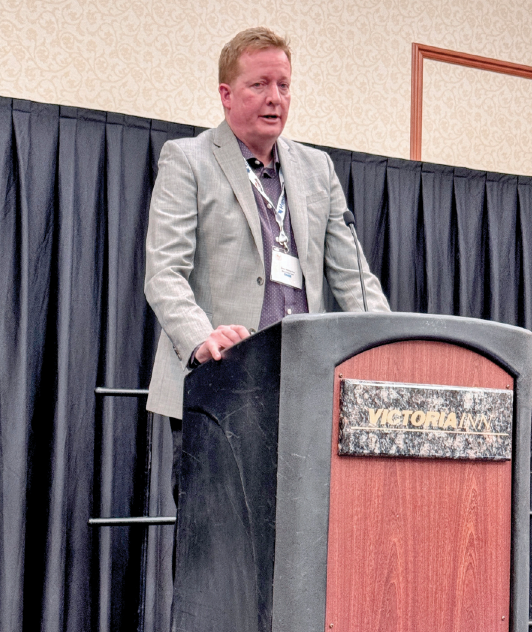
Grant Melnychuk, Director of Sustainable Development, Research, and Data Management, stood before a room filled with industry stakeholders at the two-day Manitoba Swine Seminar in Winnipeg, MB, Feb 7 and 8, ready to deliver an insightful update on the economic landscape of Manitoba’s hog sector. With precision and clarity, Melnychuk embarked on a journey through the intricate web of statistics, trends, and projections that define the province’s bustling hog industry.
“Okay, thank you very much, Robyn, and thank you for the welcome this morning,” Melnychuk began, acknowledging the warm reception. As he settled into his role as the stand-in for the general manager, Melnychuk dove straight into the heart of the matter: the economic impact of Manitoba’s hog sector.
“The focus of our industry update this year is going to be an economic update,” Melnychuk explained. “We’ll specifically look at the economic impact of our sector, from farm to processing, highlighting our sector’s contribution each year.”
In a rapid-fire succession of statistics and insights, Melnychuk painted a vivid picture of the hog sector’s vitality. “There are currently 624 hog farms in the province,” he stated, underscoring the sector’s substantial presence. Manitoba’s hog industry is on solid ground, with a staggering 5.2 million finished hogs produced last year.
As Melnychuk delved into the sector’s global reach, he highlighted its significant contributions to domestic and international markets. “We market to 25 countries around the world, with the US and Japan leading the pack,” he noted. Despite facing challenges, such as fluctuations in market demand, Manitoba’s hog sector has remained resilient, maintaining a steady position as the third-largest contributor to farm cash receipts.
The narrative of growth and evolution continued as Melnychuk shed light on trends shaping the sector’s trajectory. “Farms have been getting bigger, with fewer of them than in previous decades,” he observed. Against this backdrop of change, Manitoba has emerged as a critical player in hog processing, accounting for 23 per cent of hog processing in the country.”
Yet, amidst the statistics and trends, Melnychuk emphasized the holistic approach taken to measure the sector’s economic impact. “We wanted to include the entire sector supply chain,” he explained, highlighting the interconnected nature of the industry. A comprehensive picture of the sector’s economic footprint emerged through meticulous analysis and expert consultation.
“Each year, Manitoba’s hog sector contributes 2.3 billion to the provincial GDP,” Melnychuk revealed. With 22,000 Manitobans directly or indirectly employed in the sector, its significance reverberates throughout the province.
As Melnychuk fielded questions from the audience, addressing inquiries about corn farmers and housing conversions, a sense of optimism filled the room. “Manitoba is a leader in production and processing,” he affirmed, citing economies of scale and robust infrastructure as key drivers of the sector’s success.
“Why is Manitoba a leader in this industry?” pondered Melnychuk. “I think it’s an excellent question, and I’m sure there are many reasons for it, but economies of scale is one of them. I mean, several barns and a number of large markets result in spinoff investment, whether it’s to expand processing plants or other facets of the industry. The fact that there are processing plants in Manitoba is key as well. That’s a benefit we have.”
Melnychuk emphasized the robustness and resiliency inherent in Manitoba’s hog sector, highlighting its ability to weather the storms of economic uncertainty. “Because of that robustness and resiliency in the sector, I think we can weather the storm and continue to grow and prosper,” he concluded confidently.
As the discussion shifted, Melnychuk addressed a query about hog farm conversions to housing status. “Do you know how many south farms still need to convert to housing?” an audience member inquired. Melnychuk admitted, “I don’t have the exact number, but I’m sure one of my colleagues, if they are here, could probably give you an exact number.” He estimated, “I want to say it’s probably around 30 to 40 per cent left. But if you follow up with me, I can confirm that. It’s in that ballpark with over half converted, but it still needs more work.”
In closing, Melnychuk reiterated the sector’s resilience in the face of challenges and its unwavering commitment to growth. “We are a resilient sector,” he declared, echoing sentiments shared by industry stakeholders across the province. With eyes fixed on the future, Manitoba’s hog sector stands poised to continue its legacy of prosperity and innovation. •
— By Harry Siemens




